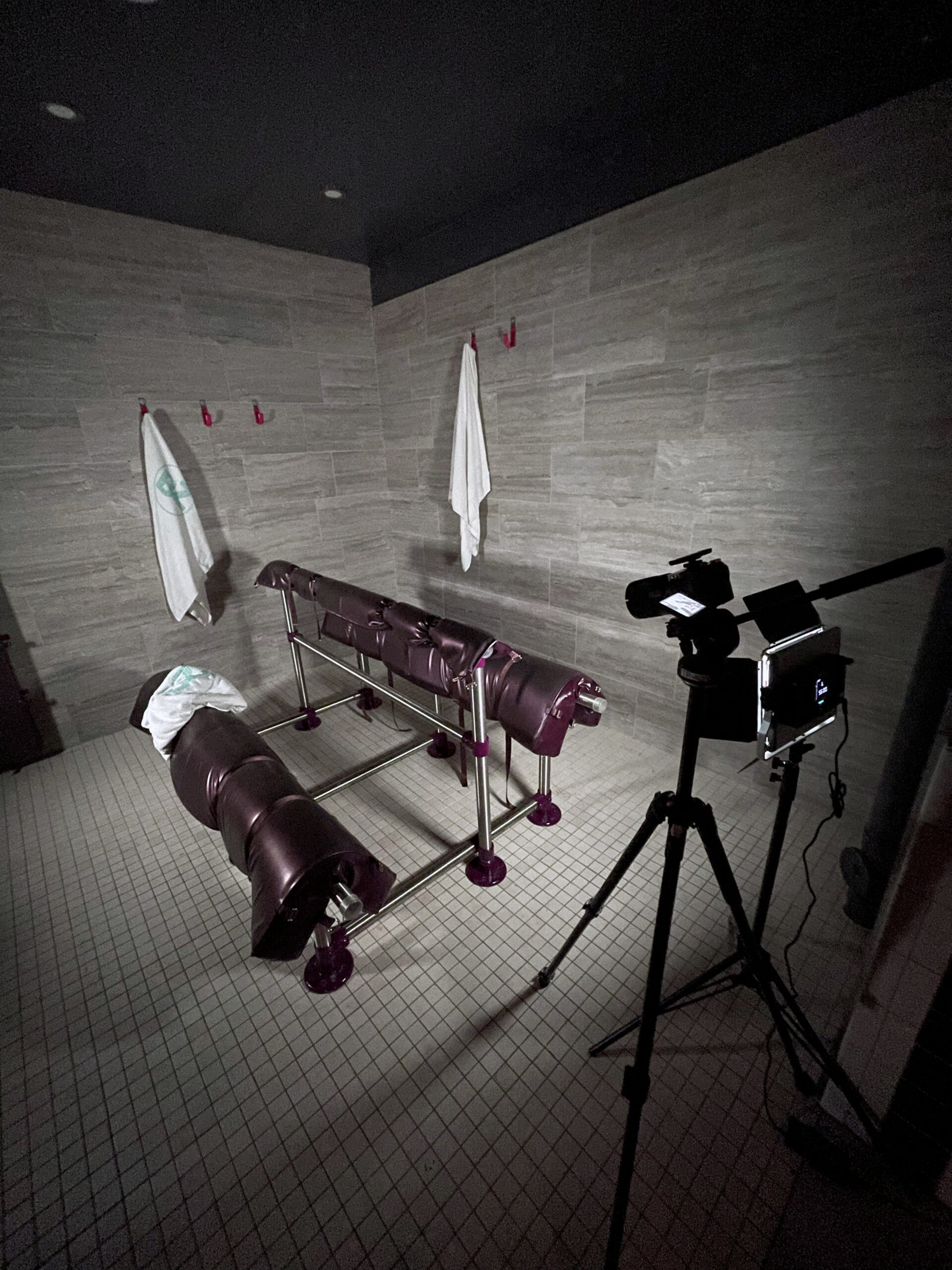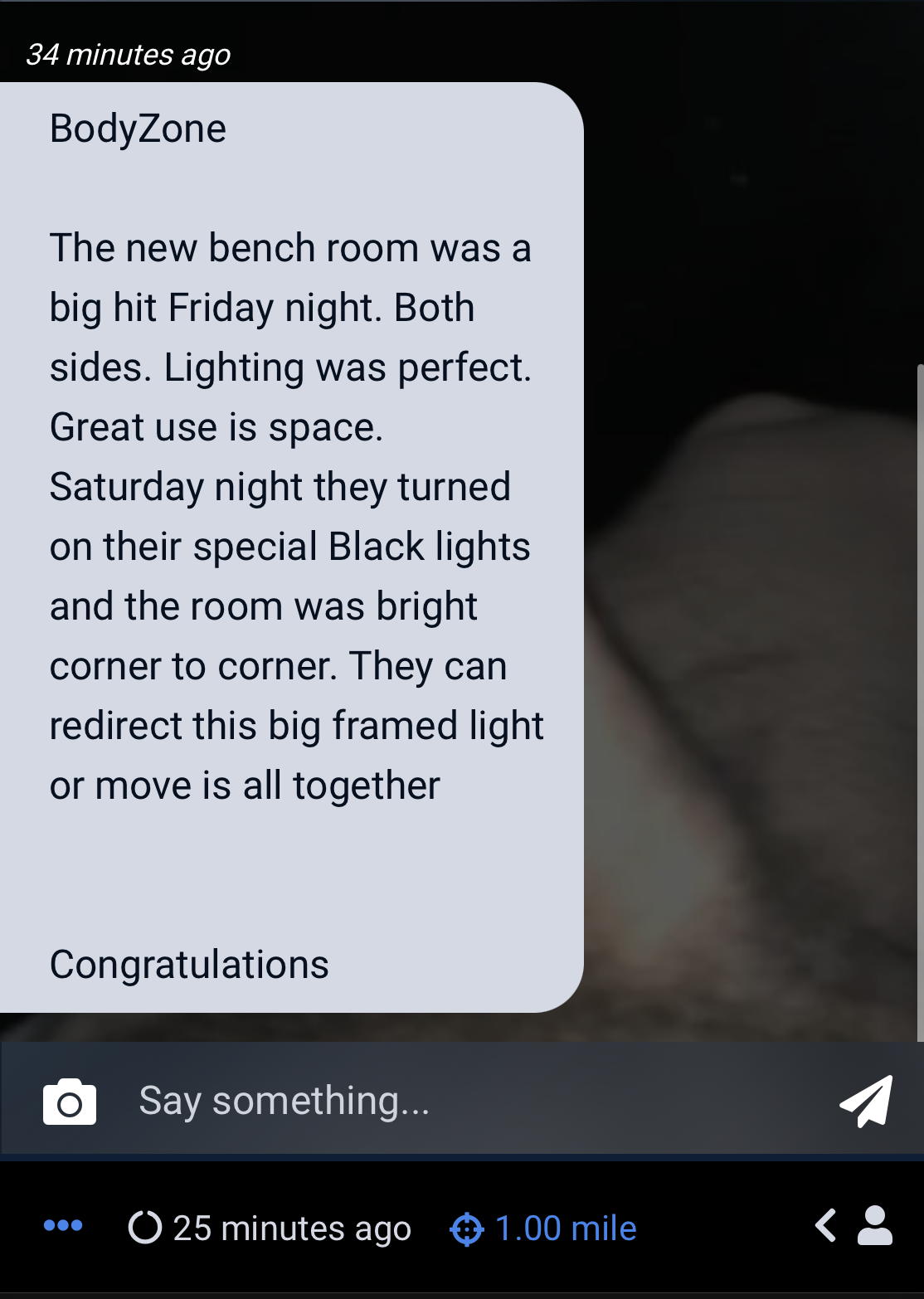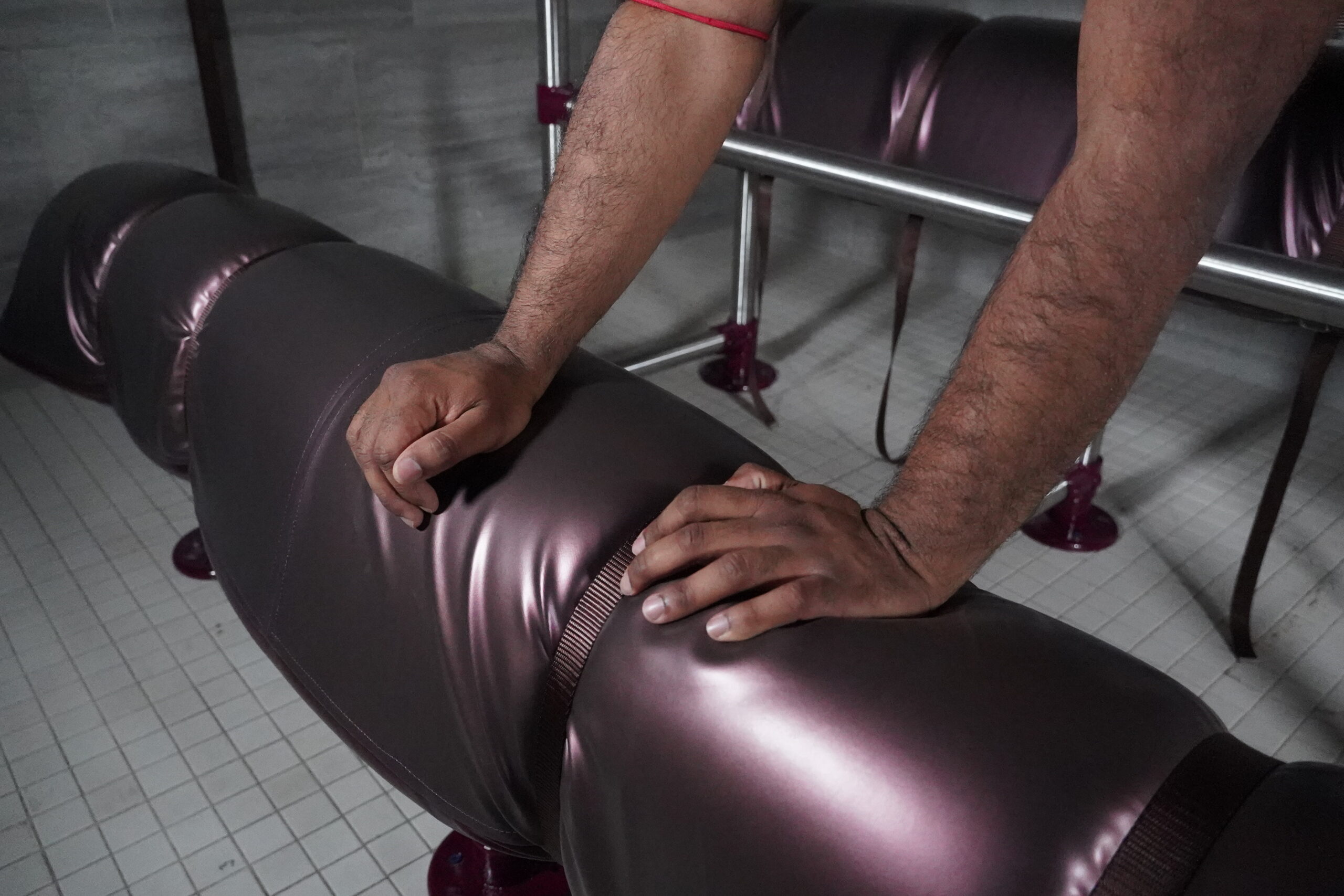The Body Zone
Strat Coffman designed their League Prize installation, The Railings, for a Detroit bathhouse.
Strat Coffman is a 2024 League Prize winner.
Trained as an architect, Strat Coffman’s practice incorporates installations, set pieces, guerrilla performance, and body furniture. Coffman’s provocative objects and installations engage the live body, often tactilely, in new orientations toward systems of design such as building codes and generic products, inviting, in the designer’s own words, “misinterpretation, readjustment, and misuse.” For their League Prize installation, Coffman departed from the gallery setting to design and install an exercise structure for Body Zone, a bathhouse in Detroit.
This summer, in a conversation that ranges from the aisles of Home Depot to the North American Bathhouse Association Conference, the League’s Jacob R. Moore spoke with Coffman about strategic ambiguity, the role of sensation in architecture, and the bathhouse as a building typology.
*
Jacob Moore: It’s an interesting challenge to focus on the installation as part of your overall body of work. I’m curious about the timeline. How did your engagement with this client line up with coming across the [2024 League Prize] “Dirty” theme?
Strat Coffman: I had recently wrapped up the work that I was doing in Michigan as part of the fellowship [Architecture Fellowship at Taubman College of Architecture and Urban Planning], and I had a lot of remnant materials. For this installation, Erotica Generica, I bought a ton of these generic commercial building fixtures, which are not cheap, so from the beginning I tried to design the assembly of parts in a way that the fixtures could be stripped and returned. After we de-installed that project, what remained were all these railings, grab bars, and knobs. I knew that I wanted to remix those in some way.
I had also started going to this bathhouse over the winter. The winters here in Michigan are just interminable and gray. And so I needed some kind of space to uncover and air out. I’d been going to The Schvitz, an old-school Russian bathhouse that is this legendary institution here, and then got curious about what other steamy spaces were in Detroit. I had heard about Body Zone. But to go into Body Zone, you have to be a club member—because of the way that permitting works in Detroit, the membership structure allows what happens in the interior to be a bit more open-ended—so I joined and ended up going throughout the winter.
So while I had been spending lots of time in these spaces that quietly mess with ways bodies make contact with one another, I also had on hand a bunch of material components that are designed to regulate touch. This is the situation the League Prize crawled into. I wanted to use the exhibition to test the behavioral norms embedded in this “material armor,” to stretch them beyond their common roles as antiseptic guards, and also put pressure on exhibiting as its own kind of touch-averse regulatory practice. I was searching for a site and a couple friends were like: Why not bring your interest in touch to these spaces that are so much about the pleasure of anonymous contact, but also relaxation and forms of social repair?
Moore: In that context, physical proximity is so important. How did you think about the virtual format of the exhibition?
Coffman: I was thinking a lot about that because, in circulating images of the play bench to an audience outside of the immediate community and clientele of the club, I really don’t want to undermine the relationship of trust that upholds that space. I was reminded by the owner that there are members who rely on discretion—that is the precondition for them to find forms of pleasure and intimacy there. But also, there was something exciting about a different way of representing space that sidesteps the common impulse which drives architectural documentation to render the totality of the pretty picture, something that’s easily digested and makes fully legible the thing. It was important to me [for the digital documentation of the installation] that the lighting and the fragmentary shots left out parts of the scene, that the gaze of the camera drifted, acting as an accomplice of underexposure rather than the mechanism of illuminating.
Moore: I really appreciated the sensitivity to the client or the space for reasons of potential exposure, and because of the policy and regulatory context. But I think what you’re speaking about now is a kind of strategic ambiguity that serves multiple purposes. Who were you imagining looking at this thing when you were putting together the digital installation? How did you play with the tensions or contradictions in that potential audience?
Coffman: I’m glad you picked up on that. It’s been funny to track the response, from a knowing audience, to people who are less familiar with these kinds of spaces. I was erring on the side of caution and just trying to edit and edit because to me the role of this structure, or the multiple roles, felt so, so obvious. But misinterpretation is not just “missing the point” or the mark of an outsider. For me it’s also spooky and thus productive. It opens up new pathways for the project to move into, it exposes the weird crossover between the marginal and the normative, like how a couch so easily becomes something else and back again, as JD Vance knows so well.
I think also, generally, my work responds to the way that minority sexual identities often get compressed within design discourses into an aesthetic or associated with a set of typologies. I’m more interested in the erotics of things that are less overtly tethered to identity, or that are less legible to a specific use case or aesthetic history or even legal category.
Moore: It’s an important reminder. In your League Prize lecture, you talked about Audre Lorde’s framing of the erotic as a wellspring of feeling and sensation. The installation plays with that and uses the multiple audiences and stakeholders to keep turning around some kind of center that is more a feeling than anything else. I’m wondering, in that sense, if you could continue speaking about how this [installation] relates to your other work. In particular, about the way that work like this has impact through iteration: you touch a knob, which makes you think or feel a thing you didn’t before, and then six months later, you touch a similar knob and you have memory of the last knob, and something slowly but surely changes in how you think with your body and act on those feelings. Does that resonate with you?
Coffman: Yeah. I’m into that way of thinking about it, because so much of my work is fueled by an understanding of architecture as a set of cues that we learn by repetition. How to properly enter a room or handle a stairwell; these are all learned behaviors. I love the idea that there are also repeated moments of unlearning or de-familiarizing that can connect across different sites. I was really excited about taking the same fixtures that had appeared in one site that’s governed by its own particular norms of comportment and behavior—the gallery exhibition setting—and then reintroducing them in this other space where there’s all these subtle, learned forms of non-verbal communication like sharing glances or brushing someone on the shoulder, on the ass.
It was exciting to think about the roles that fixtures can play and push against those norms a bit in the gallery context, and then in this other context, invite further kinds of play, and then eventually return them back into the material economy of these large commercial suppliers. At some point, it would be so cool to sneak these altered fixtures into Home Depot or Lowes as a guerilla display or even produce them as a legit commercial line of kinky off-the-shelf appliances.
Moore: Tell me more about that direction, or other ones … What’s cooking?
Coffman: I was invited by the owner of Body Zone to present this project at the North American Bathhouse Association Conference in New Orleans. I’m really excited about that, because I would love to design more things for these spaces that have often been neglected by the architecture and design fields. Many of them [bathhouses] are the result of years of ad hoc renovation or fitting into existing formerly industrial facilities. Body Zone used to be a tool and die shop and The Flex in Cleveland is in a former Greyhound depot station. I would love to offer my capacities as a designer to improve, augment, and bring more design sensitivity to these spaces. It’s my dream to someday help bring into being a ground-up bathhouse that proliferates other, queerer modes of play.
I’m still interested in producing work for gallery exhibition settings where the conditions for work to exist are a little bit less tethered to a use or a client. But it felt really good to design something for a space that was not a gallery. The installation actually had to accommodate weight and movement. One of the things I learned during this process was that, while the League Prize gave me the excuse to do this work, I could have approached Body Zone regardless. I think that was something that I realized: there’s ways of initiating work without institutional support or approval, through other peer, self-organized, or informal networks. That’s something that I want to do more of now, approach spaces like this or organizations. There’s so many ways of making work.
Interview has been edited and condensed.





